Japanese iris: varieties, planting and care

When the first half of summer is left behind, many flowers have time to bloom, which makes the flower beds look less elegant. But there are flowers that continue to delight the eye with their beauty until autumn. Among them is Japanese iris, known for its graceful and bizarre shapes. In total, there are about a thousand subspecies of this plant, and in this material we will talk about the most famous varieties of this flower. You will also learn about the intricacies of planting this perennial and about the features of caring for it.


A bit of history
There is a legend that beautifully tells about the appearance of graceful and unusual irises on earth. One day the rainbow did not disappear, as it usually happens, but shattered into colored fragments. Falling to the ground, its pieces turned into multi-colored variegated irises.

In the Land of the Rising Sun, this flower is treated with the greatest respect. Large-scale festivities dedicated to irises are held here. One of them is called Cebu no sekku, or Boys' Festival, and is celebrated on May 5th. At this time, there is a ritual contemplation of these flowers in the gardens. In the Japanese language there is a separate word for this process - "hanami".
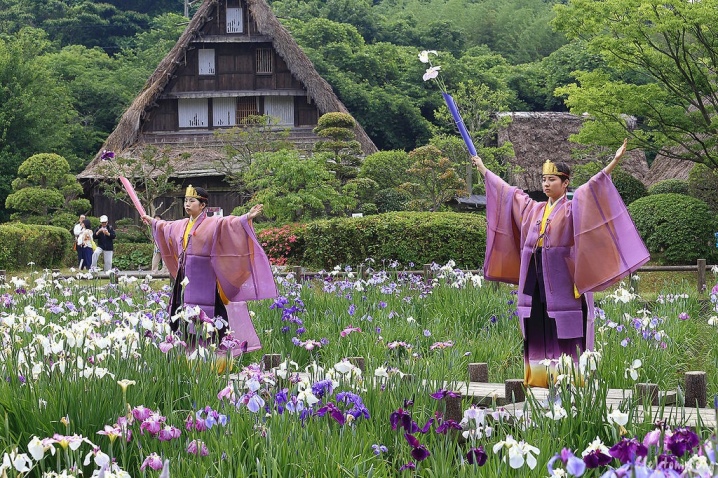
Because the narrow leaves of the iris look like sharp blades, the Japanese associate them with samurai swords. By the way, in the language of this country, the words "iris" and "military spirit" are spelled the same way.
According to legend, if you make a necklace from Japanese irises and put it on, then it will save you from sins and ailments of the body.
The roots of flowers are used by the Japanese in the production of perfumes, exquisite alcoholic beverages and sweets.


Description
If you believe that irises originated from fragments of a rainbow, then in the Japanese city of Savara, its particles fell into the water. The most beautiful water garden of irises is located here. It is known that in Japan, meadows with these flowers are sometimes flooded with water, but this is permissible only during the period of their active flowering... Despite this inspiring and picturesque example, you should not follow this tradition and try to recreate the water garden of irises in our climate. Usually such experiments do not bring the desired results, but flowers can rot from excess moisture.

One of the main features of these flowers is that they only need watering when they bloom. The rest of the year they "doze" in the ground and practically do not need watering.
This makes Japanese iris a welcome guest in summer cottages, city flower beds and adjacent territories. Another distinguishing feature of the plant is its large flowers with a diameter of 14 to 25 centimeters, which makes them noticeable against the background of other inhabitants of flower beds. Their structure includes 3 external lobes, a perianth and small internal lobes. The leaves of this perennial are even more impressive in size - from 25 to 60 cm.

Traditionally, these flowers grow in swampy meadows and edges of Asian countries, but the word "Japanese" is rooted in the name. The flower remained an exclusively oriental plant for quite a long time, but when it was taken to other countries, the breeders began to breed various forms. Thanks to the work of such specialists, today we can choose from the widest range of varieties of Japanese iris. They differ in flowering time, cold resistance, shapes and shades.In the Land of the Rising Sun, these flowers are preferred to be planted in lowlands, irises are very fond of moist soils, and in this position, the water can stagnate longer.

These beautiful exotic plants came to Russian soil more than a century ago. Botanist Eluard Regel wanted Japanese irises suitable for growing in temperate climates. As a result of trial and error, several varieties have been obtained that can take root in our rather harsh climatic conditions. His work was continued by the scientist Vasily Alferov, who received the groups popular today.

Note that in the homeland of these flowers, the Higo category is distinguished, which includes 3 thousand subspecies. They are grown in containers, so Higo is used as both garden and indoor crops. They can perfectly dilute house flowers familiar to the eye and add bright colors to a room greenhouse.

Disadvantages and advantages
These beautiful flowers have their pros and cons that summer residents and gardeners need to know about. The disadvantages include the following qualities:
- weak frost resistance;
- lack of aroma;
- the life of flowers is from 3 to 5 days.

The undoubted advantages of the flower are:
- tolerance of many diseases;
- large flowers.

Varietal variety
"Crystal halo"
Its lower petals are large and round, they are decorated with a light border and purple veins, and the upper lilac flowers have white spots and a yellow middle. Although the flowers are small - only 15 cm in diameter - they look very impressive. On a stem up to 0.9 m high, 3 inflorescences huddle. Looks advantageous with white irises and daylilies.

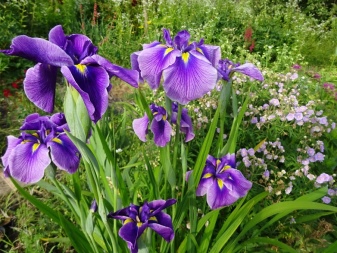
Eilins Dream
The double purple flower has yellow arrows with a lilac border. There are from 9 to 12 petals. They have a velvet surface and a corrugated texture.

Kita no seiza
Lilac 14-centimeter inflorescences are decorated with yellow blotches at the base of the petals, and the border between the green base and the bright pigment of the petal has a very sharp transition. There are 15 petals in total, they are covered with graceful white veins.


"Rose queen"
Its stems grow up to a meter, they are covered with hard narrow leaves emanating from one point. Lilac flowers have a pleasant pink tint. Fouls are decorated with yellow inclusions and dark purple streaks. A successful breeding option would be pre-landing in containers, and then immersion 7 cm into the reservoir.
The variety is good for its resistance to cold - it tolerates winters with temperatures down to -15 degrees.
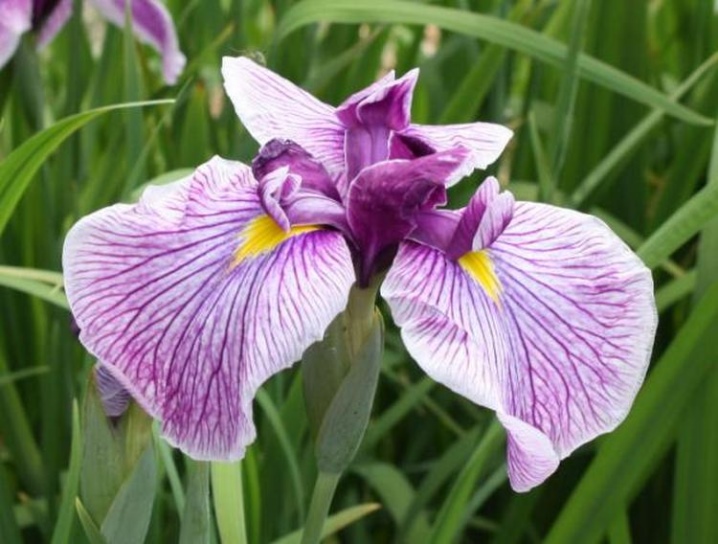
"Variegata"
It has variegated leaves, that is, leaves with a mutated color - they are green with light golden stripes. The stems are adorned with large deep purple flowers. The growth of the stems is not the highest - up to 0.75 m.


"Vasily Alferov"
Named after the breeder who had a hand in the creation of numerous varieties of Japanese irises, suitable for the climatic conditions of our country. The height of the stems of this variety reaches 1.1 m, and the flowers themselves are quite large - 20 cm in diameter. This is a suitable option for lovers of large irises.

How to plant?
Choosing the right place for flowers is the key to their healthy growth and lush bloom. They love sun-drenched areas, ideally the area should be well lit. Also, these exotics can take root in partial shade, and in very dark places they are unlikely to be able to bloom. Weakly acidic loams are well suited for these perennials. They also love compost fertilization, but due to potassium intolerance, Japanese irises will not grow in open ground with lime. Alkaline soils are not to the taste of these capricious beauties.
Before immersing the stem in the ground, the leaves and roots are slightly shortened. The grooves for flowers should be placed in increments of 30-35 cm. Stick the stems into the soil to a depth of 3-7 cm. If you decide to divide an already growing shrub, then the resulting stems need to be sunk into the soil deeper than they grew before.After the plants are planted, they need to be watered.

How to take care of it properly?
Despite the fact that Japanese irises are resistant to many ailments and pests, they have their own weaknesses. One of them is the need for gentle care.
Most flowers of this species do not like frost, but with the appearance of the first spring rays, they rush to growth.
Do not spare a good covering material for them so that the accidental drop in temperature does not overcool them. Mulching is best done with pine nut shells, coniferous waste or crushed bark.
The land beloved by irises is filled with rainwater. In order to create such a "mini-pool" for them during the flowering period, summer residents sometimes enclose their site with peculiar bumpers so that water can be retained in them. But in such a design, it is necessary to provide for a drainage system so that flooding does not happen.

Diseases and pests
Japanese irises rarely fall prey to pests. Their resistance to infectious diseases is also high. Of the pests, thrips can damage them, and insecticides will help get rid of them. After removing the dried leaves, burn them to get rid of the eggs laid by insects. It is worth cutting off the spoiled leaves only after the onset of cold weather, otherwise this process will negatively affect flowering.

Examples in landscape design
- The place of planting of irises in the compositions is determined based on the maximum height of a particular variety. Those that reach the meter mark or higher are traditionally planted in the background or in the middle plane of the compositions. An excellent background for these irises is juniper, thuja, barberry, currant, gooseberry or any deciduous shrubbery.
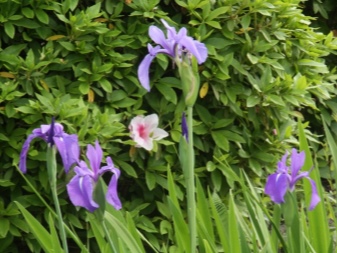
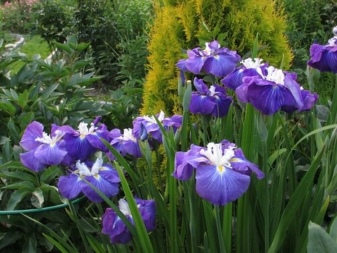
- "Kids" 50-75 cm look beautiful both in the foreground of flower beds and in alpine hills and other low-growing vegetation.

- As for stone gardens, deep purple and purple specimens will successfully complement light cobblestones, and light varieties - darker ones.


- A pond or other body of water framed by irises will become even more picturesque, and the flowers on its shore will feel comfortable. The main thing is that there is no stagnation in this place.


By the way, flower gardens, where irises are planted as the main plants, are called iridariums. But most often these flowers are still actively combined with others, so that the flowerbed is always full of flowers, and not only during the flowering of irises. Planting them as curbs is also not very practical, since the flowering period of these flowers is not so long.
Beautiful and large Japanese irises will be a bright decoration of a summer cottage or local area. These light-loving perennials have many varieties, among which you can certainly choose your flower. Use our recommendations for planting and caring for irises, and they will delight you for a long time with their graceful beauty and unusual shape.


For information on how to properly plant bulbous irises, see the next video.







































































































The comment was sent successfully.